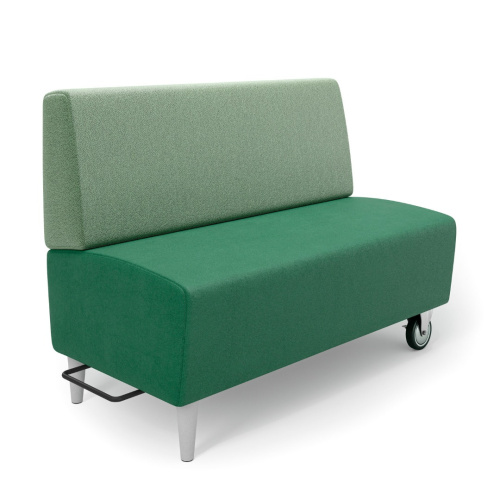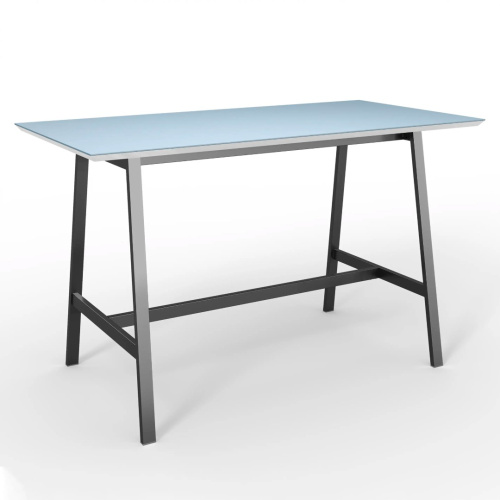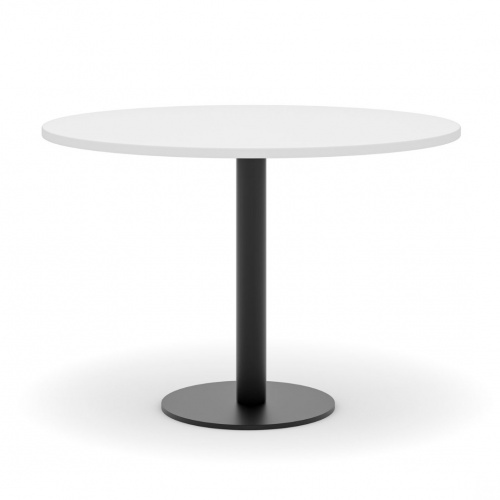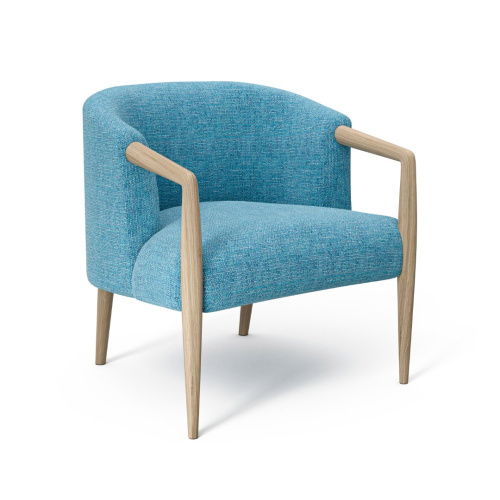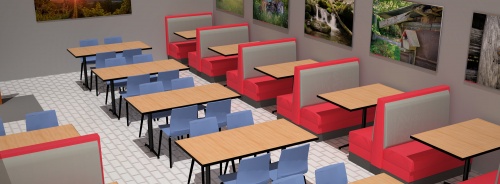A Guide to the Different Types of Coated Fabrics
Coated fabrics are used in a diverse range of industries, from automotive, transportation, and aerospace to marine, healthcare, sports and leisure, and industrial sectors. They serve a vital purpose in the furniture industry as well, assisting companies in safeguarding their clients and adhering to applicable codes and regulations. With over half a century of experience in crafting high-quality furniture for the hospitality sector, Falcon has maintained a deep understanding of the applications, attributes, and benefits of coated fabrics with dozens of coated fabric options.
The upholstery fabrics we offer often undergo different types of coatings to make them more suitable for specific uses. In this article, we introduce you to the world of coated fabrics, shedding light on their production process, their application, and the diverse types available on the market today.
What is a Coated Fabric?
The term “coated fabric” refers to a textile that has been chemically treated with a specialized coating to alter, enhance, or improve its properties. This treatment offers a broad range of benefits that are both aesthetic and functional. Primarily employed to strengthen durability, these coatings also produce other desirable qualities such as water and fade resistance, increased resilience to wear and tear, thermal and antimicrobial protection, as well as fire retardancy.
The process of creating coated fabrics involves the application of a layer of polymer or other coatings onto a base textile material, thereby enhancing its properties and imparting specific functionalities. Common types of coatings used for upholstery fabrics include vinyl, silicone, acrylic, and polyurethane. Textile manufacturers have the flexibility to tailor coatings to particular fabrics, catering to diverse needs and the requirements of specific applications or venues, such as hotels, restaurants and hospitals.
Different Types of Coated Fabrics
Vinyl Coated Fabrics
Vinyl coated fabrics are known for their durability, versatility and low cost. They consist of a base fabric, usually polyester or nylon, which is coated with polyvinyl chloride (PVC) or polyurethane. Coating the fabric with PVC creates a waterproof and durable material. Vinyl coated fabrics are available in different weights and thicknesses, offering varying degrees of strength and flexibility.
Pros:
Waterproof: Vinyl coated fabrics are highly resistant to water and provide excellent protection against rain, making them suitable for applications such as outdoor furniture.
Durable: They are incredibly robust and are resistant to corrosion, chemicals, abrasion, and impact, making them ideal for use as upholstery in public or heavily trafficked spaces.
Cost-Effective: Vinyl is less expensive than many other plastic coatings, making it an economical choice for various projects.
Color and Design Options: Vinyl fabrics are available in a wide array of colors and designs, giving users ample choices for their specific needs. They are easily customizable, so they can be made to match virtually any color or texture.
Cons:
Environmental Concerns: Traditional PVC-coated fabrics raise environmental concerns due to the use of phthalates and other potentially harmful chemicals during production. In addition, they are not biodegradable and release harmful chemicals when incinerated.
Less Breathable: Vinyl fabrics tend to be less breathable, which may lead to discomfort in hot and humid conditions.
Susceptible to Cold Cracking: In extremely cold temperatures, vinyl fabrics can become stiff and susceptible to cracking.
Health Risks: PVC can release toxic chemicals which can be harmful to human health. Exposure to these chemicals have been known to cause developmental problems and other health issues.
Recycling Challenges: PVC coated fabrics are difficult to recycle because they are made up of several different components that are hard to separate. In addition, the recycling process can also release harmful chemicals into the environment.
When to Use Vinyl Coated Fabrics:
Vinyl coated fabrics are a great choice when waterproofing and durability are paramount, such as in health care environments and hotel lobbies.
Silicone Coated Fabrics
Silicone coated fabrics are extremely durable, and have a modern look and comfortable feel. They are engineered to withstand extreme temperatures and offer exceptional resistance to fire, water, and chemicals. They are considered an eco-friendly solution to seating because they remain free of solvents. These fabrics are created by applying a silicone polymer to a base fabric. Silicone coatings are applied using different techniques, such as knife coating or dip coating, to achieve the desired level of coverage and properties.
Pros:
Temperature Resistance: Silicone coated fabrics can handle high temperatures without degrading, making them suitable for applications such as car seats and indoor environments that lack air conditioning.
Chemical Resistance: They are highly resistant to chemicals, oils, and solvents, making them ideal for withstanding exposure to harsh substances, such as the disinfectants and cleaners used in a health care setting.
Weather Resistance: Silicone coated fabrics perform well in outdoor settings and have excellent UV resistance.
Cons:
Cost: Silicone coated fabrics are more expensive to produce than other coated fabric types due to the high-performance properties of silicone polymers.
Less Flexible: While highly durable, silicone coatings can be less flexible than other coatings, which might limit their suitability for certain applications, such as draped upholstery.
Slow Production: Their production speed is 40% slower than conventional coated textiles.
When to Use Silicone Coated Fabrics:
Silicone coated fabrics are best suited for environments that have extreme temperature or the presence of chemicals such as harsh cleaning solutions. They are ideal for use in outdoor furniture.
Polyurethane Coated Fabrics:
Polyurethane (PU) coated fabrics are lightweight and flexible, combining the benefits of durability and water resistance. These fabrics are created by applying a layer of polyurethane to a base fabric such as polyester or nylon. PU coatings can vary in thickness, resulting in different levels of water repellency and breathability.
Pros:
Water Resistance: PU coated fabrics are water-resistant, providing a good amount of protection against rain and moisture.
Flexibility: They are more flexible than some other coated fabrics, making them suitable for applications requiring movement and drape, such as furniture upholstery.
Breathability: PU coated fabrics offer better breathability than vinyl, providing more comfort in warm and humid conditions.
Eco-Friendly Options: Some PU coated fabrics are made using eco-friendly processes, addressing environmental concerns associated with traditional PVC coatings.
Cons:
Durability: While durable, PU coatings may not be as robust as vinyl or silicone coatings, limiting their use in heavy-duty applications.
UV Resistance: PU coatings might not have the same level of UV resistance as silicone or vinyl, making them less suitable for prolonged exposure to sunlight.
When to Use Polyurethane Coated Fabrics:
Polyurethane coated fabrics are used extensively in public settings, where a balance of water resistance, breathability, and flexibility is essential.
Acrylic Coated Fabrics
Acrylic coated fabrics are known for their excellent UV resistance and color retention properties. These fabrics are produced by applying an acrylic coating to a base fabric such as polyester or cotton. The acrylic coating helps enhance the fabric's durability and resistance to fading.
Pros:
UV Resistance: Acrylic coated fabrics are the material of choice in applications where prolonged exposure to sunlight is a concern, such as outdoor furniture, or on indoor items that are not protected from the sun’s glare.
Color Fastness: They retain their color well, even after prolonged exposure to the elements, ensuring a vibrant appearance over time.
Mold and Mildew Resistance: Acrylic coatings often have mold and mildew-resistant properties, making them suitable for humid environments, as well as hospital settings.
Cons:
Water Resistance: While acrylic coatings offer some level of water resistance, they might not be as effective as other coated fabrics such as vinyl or PU.
Stiffness: Acrylic coated fabrics can be stiffer compared to other coated fabrics, negatively affecting their flexibility and drape.
When to Use Acrylic Coated Fabrics:
Acrylic coated fabric is an excellent choice for heavily trafficked and outdoor applications that require UV resistance and color fastness.
By understanding the differences among these coated fabric types and evaluating their pros and cons, you can make an informed decision about the best material for your specific needs. Consider factors like weather conditions, temperature requirements, durability, and flexibility to select the most suitable coated fabric for your project, ensuring optimal performance and longevity.
Falcon has been producing furniture for the hospitality market for over 50 years. It offers the broadest selection and highest quality custom furniture in the industry, collaborating with a constellation of world-class fabric manufacturers to provide a wide selection of upholstery material. To learn more, visit our website at www.falconproducts.com.


